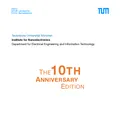10th Anniversary of the Institute for Nanoelectronics, Chair Professor Paolo Lugli
The Institute for Nanoelectronics was founded within the Department for Electrical Engineering and Informational Technology (EI) in 2002.
In Germany that marked the first time for an institute fully dedicated to nano-activities to be established in an engineering environment.
All structured activities in nanotechnology and nanoelectronics were (and still are) mainly taking place in the departments of Physics, Chemistry, and Material Science.
Because of its somewhat “exotic” focus compared with traditional engineering disciplines, the Institute was created as an explorative one, with reduced budget and infrastructure.
I was appointed as head of the Institute and as full Professor in October 2002, coming from Rome where I had spent the previous 15 years, first as Associate Professor and then as Full Professorfor Optoelectronics at the University of Rome “Tor Vergata”.
I had already several strong connections with TUM, in particular with the Physics Department in Garching, so the move was actually quite smooth.
I still remember that the vice-president that gave me the certificate as Bavarian “Beamter” mentioned that Munich is considered the most northern Italian town in Germany.
And indeed, for me coming from northern Italy, it always felt like home here in Bavaria.
Things went pretty well from the very beginning: we could start our research activity without too many delays and started offering new classes on different topics of nanotechnology.
Especially helpful was the fact that Giuseppe Scarpa, a former Diplom student of mine in Rome, had just received his PhD at the Walter Schottky Institute with Professor Amann and joined the Institute from the very beginning.
After three years the Department declared the explorative phase successfully ended, which implied a bit more space and positions.
Over the years the Institute has established itself nationally and internationally.
We have worked at the frontier of nanotechnology and nanoelectronics, as will be outlined in some details in the description of our research efforts in the following pages.
Many people have contributed to this success story and I would like to take this chance to thank them all, students, assistants, doctoral candidates, secretaries, technicians for their dedication and hard work.
The (almost always) nice atmosphere at the Department and at the University, the help of a lot of many friendly colleagues and the invaluable support of the Department administrative stuff were very precious in those years.
We have built up a colorful and friendly Institute, highly international in its composition and its range, we have established a broad research network at local, national and international level and, I am proud to say, we have reached excellency in several fields, establishing “nano” as one of the core topics of the Department and making world-wide contributions at the scientific level.
This brochure illustrates what has been going on in the Institute for the last 10 years, following its development and growth.
It was impossible to cite all results and publications, all collaboratorsand guests, all sponsors that we have had during this time. What we present here is just a small sample of an outstanding series of activities.
The next ten years are going to be exciting and I am looking forward to them (a bit less to the retirement that will come at the end of this period).
Already in 2013 two new Associate Professors are going to join the Institute, three European projects will start, new people will come and many will move on in their carrier.
wwwt3.nano.ei.tum.de/fileadmin/w00bsr/www/2012_10th_anniversary_booklet-FINAL-5-ACROBAT.pdf
https://portal.mytum.de/pressestelle/tum_mit/2003nr1/47.pdf
